Our Nepal treks travel through one of the world's great mountain ranges, home to some of the world's highest mountains and surrounded by stunning scenery, a fascinating history and wonderfully welcoming communities. Nepal is continually a favourite for many travellers and a Nepal hiking tour offers the perfect safe adventure holiday.
From accessible Nepal trekking holidays, to more challenging and remote routes, we have a range of superb treks in Nepal including the well known Everest Base camp trek and Annapurna Circuit trek, to the less visited places such as the Kanchenjunga trek, Rolwaling trek (with Parcharmo peak) and the Manaslu Circuit trek to name a few.
About Hiking in Nepal
It would be hard to do justice to a Nepal hike even in a lifetime, there is so much to see and do! Nepal is a safe place to visit and the trekking trails are wonderful places to re-connect with nature and walk amongst the mountains. Nowadays the hiking in Nepal is much more comfortable than the rugged experience it was in the 1950s when Edmund Hillary climbed Mount Everest. There are comfortable tea houses selling a wide variety of local and western foods (and beer), even luxury hotels in the lower regions. Lots of trips to Nepal focus on the culture as much as the scenery, but there is also ample opportunity to find yourself in real isolation and beauty.
Adventure Alternative Nepal employs local Nepali guides to offer you the most authentic trekking experience, offering either the popular routes like Annapurna Circuit and Everest Base Camp, and also bespoke Nepal hike and trekking itineraries. We love to give back to the communities we operate in, and our relationship with the Sherpa communities in the solu Khumbu is is nearly thirty years established with our charity partner Moving Mountains. For three decades we have been using the proceeds from tourism to fund education and health in those villages.
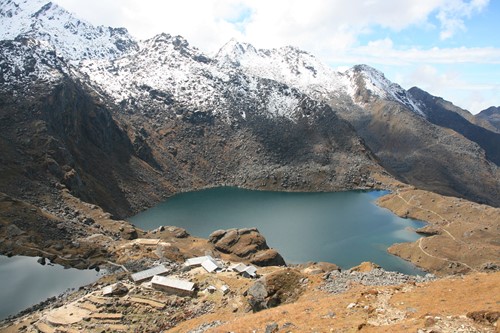
High alpine lakes in the Langtang Region, a very popular trekking region with the option of some trekking peaks like Yala Peak to add onto your holiday.
How to Choose Where to Trek in Nepal
Nepal has seemingly countless treks and it’s easy to see why it’s so hard to choose just one Nepal hiking tour. Select your trek based on how much time you have, the difficulty of the trek itself and if you know the particular mountain region you would like to visit.
The first thing to consider is how much time do you have to trek? Most trekking routes require 15-22 days to complete. If you only have a week to spare for your trip to Nepal and would be looking for short treks, then a trip out to Poon Hill is a must. We also run shorter treks to the Sherpa villages in the solu Khumbu, a chance to experience traditional Sherpa life and see the work of Moving Mountains. These treks run for a week to ten days and the Poon Hill culminates in watching the sunrise from the iconic viewpoint. If you have around three weeks, consider exploring the Mustang Region, Manaslu, or Gokyo Lakes, while the two week holiday lends itself well to the Annapurna Circuit, Annapurna Sanctuary or the Everest Base Camp Trek, all of which are classic Nepal hiking tours.
Secondly, what region would you like to discover? Nepal has several different regions, each with their own unique environment and personality. The Khumbu region which culminates in the Khumbu glacier that comes off the slopes of Mount Everest, is popular because of the highest mountain in the world and the experience of walking in this great high valley surrounded by huge peaks. It is very well serviced with a famous airport at Lukla and there are many good quality lodges to stay in. However, by and large the route out is the same as the route in, which is the same as the Langtang Valley trek which has an in-built circular addition to see the traditional Tamang villages.
The remote kingdom of Mustang and the Dolpo regions of Nepal are more arid, it's in the rain shadow of the Himalaya and have a longer season which starts in September. This is an area popular for horse riding itineraries, and the hikes here are rugged but steeped in history and culture. The lodges are not as modern as the Khumbu region, and you will still find isolation among the peaks.
The Annapurna range has held visitors in its thrall as much as the Khumbu region, and iconic treks on the Annapurna Circuit or to visit the Annapurna Sanctuary last around two weeks from the starting point of Pokhara. The lodges in this region are well serviced and quite westernised again, and the views from the Thorong La (pass) are completely worth the effort of the hike up there.
A more remote Nepal hike would be the Manaslu Circuit, which is slightly longer and more challenging. Similarly the Kanchenjunga base camp trek on the east side of the country is often described as the finest trek in Nepal but you need three weeks in country to complete this incredible route to the base camps of the world's third highest peak.
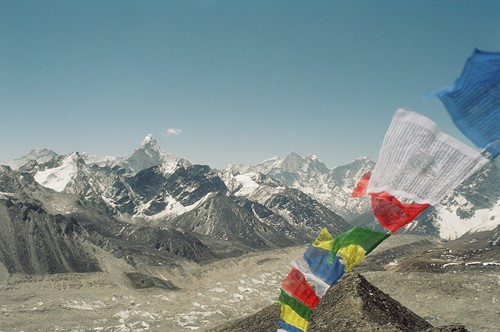
Prayer flags and mountains are iconic scenes on Himalayan treks. This is the view from the famous Kala Patthar, the high point of the Everest base camp trek. The fine mountain on the horizon is Ama Dablam and the glacier in the foreground is the Khumbu glacier which comes directly from Everest itself.
Lastly, think about your fitness and altitude. Although anyone who is relatively fit can trek in Nepal, some of the high passes and base camps reach altitudes of up to 5500+ meters. Be sure to be in good physical shape, and understand the challenges associated with spending many days at high altitude. The advice is simple but effective: eat well, drink well, sleep well and go slowly! Unfortunately the impact of hypoxia on the body at altitude makes it hard to eat and sleep, and the thin dry air lends itself to dehydration.Training at home for a Nepal hike will help, especially cardio-vascular training like swimming and lots of hiking, and working on the thigh and calf muscles.
There is a difference between being fit and mountain fit, and most people don't know how they will perform at altitude on a hike in Nepal. There is a lot to be said for having an efficient walking style which is efficient and doesn't waste energy, but perhaps the most important advice is to always go slowly and allow your body to acclimatise.
Khumbu Region
When most people think of Nepal, they think of the Khumbu. Home to Mount Everest, this region boasts the highest peak in the world. It comes as no surprise that this region has the most popular Himalaya Trails in Nepal. The trek to Everest Base Camp sees countless visitors each year. The Everest Base Camp Trek is on of the most popular treks in Nepal. Many people ask 'how hard is it to trek to Everest base camp', which you can read more about on this link. This area is also home to several other popular trekking routes, such as Gokyo Lakes, where you can get the best panorama in the Himalaya.
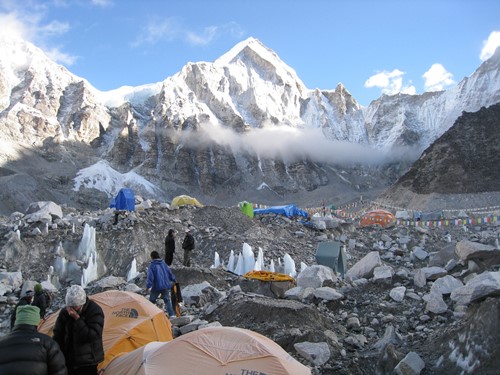
Views of Everest Base Camp which is at 5600 metres and probably most famous Nepal hike . Visitors can trek onto the glacier and have lunch here and see the climbing teams camped below the massive Icefall, preparing to head up to Camp 1.
The only way in and out of the Khumbu is to either walk from Jiri, or arrive by small aircraft via Lukla. The runway into Lukla is slopped at about 12 degrees, with a cliff on one end and a mountain on the other. It’s sure to raise the hair on your neck!
Annapurna Region
Annapurna is the second most well-traveled trekking region of Nepal. Trekking altitudes are a bit lower than what you see in the Khumbu and logistics in and out of the region are easier as well. Most treks begin in the city of Pokhara, a beautiful settlement nestled next to a stunning lake. Our Annapurna Circuit Trek or the shorter Annapurna Sanctuary Trek, also known s the Annapurna Base Camp Trek, touches on all of the highlights, including stunning vistas of Annapurna herself. If your looking for a less-crowded base camp our Annapurna Sanctuary Trek makes a stop at Annapurna Base Camp. For those short on time, Annapurna panorama trek, also known as Poon Hill offers an excellent opportunity to trek and enjoy the views without the time commitment.
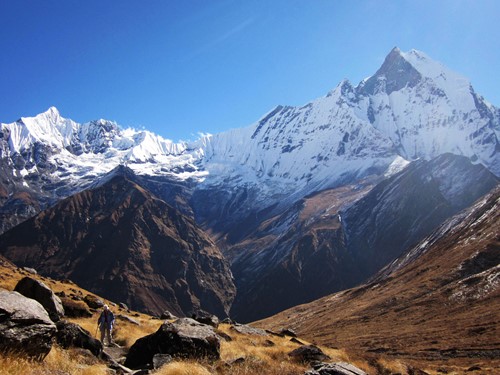
Views of Annapurna on the trails around the Annapurna Sanctuary.
Mustang Region
The Mustang Region of Nepal is an isolated and remote region nestled in the Himalaya. Unlike many of the other trekking regions, Mustang has a more cool and arid climate. Traditional Tibetian Buddhism dominates life in this unique region of Nepal. Its semi-independent people follow a great tradition of myth, mystery, and history. Mountains surround the region, however, there is much more of a high-desert feel here. Scenery differs from that of much of the rest of the Himalaya. With only around 1,000 visitors per year, you will truly feel as if you’ve stepped into another place.
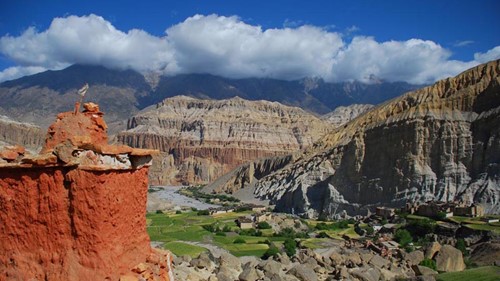
The unique landscape of the Mustang Region which was closed to visitors for a long time.
Manaslu Region
Manaslu is the eighth tallest mountain in the world (8,156m). Another off-the-beaten-path destination this trek takes you through mountain passes and lush forests. The trek around Manaslu eventually join up with the Annapurna Circuit nearby. This Manaslu trek is an excellent option for those looking to enjoy views to 8,000m peaks without the crowds.
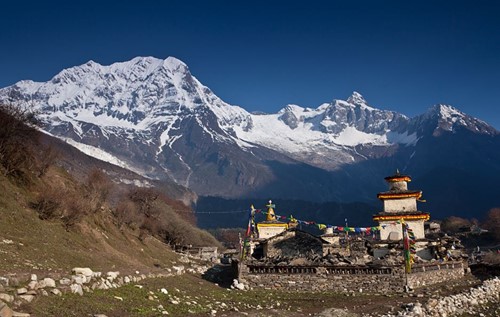
The views near Manaslu, this circuit is regarded as one of the finest to complete and is still fairly untouched.
Langtang Region
Langtang is Nepal’s first national park. Located near Kathmandu, it offers some of the most accessible trekking routes in the country. The area is well known not only for its mountain beauty but also for its wonderful culture. There is abundant wildlife and plenty of different mountainous climates to explore. Our trek to this region is one of the lowest in elevation, topping out at around 3,500m. This is the perfect trek for those looking for a less intense trekking experience.
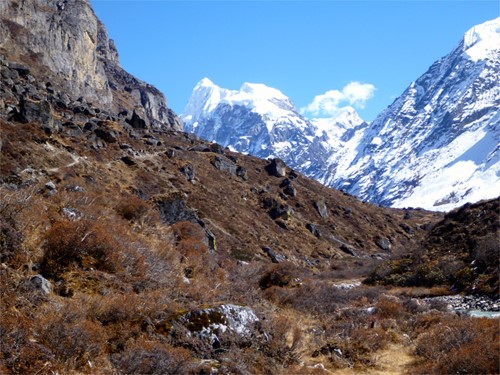
High alpine scrub forests meet ice-covered peaks in Langtang valley, the closest national park to Kathmandu.
Other Nepal Trekking Experiences
We offer a variety of peak climbing at many of Nepal’s “trekking peaks.” Trekking peaks in Nepal are named so by the Nepalese authorities and provide an excellent opportunity to climb in the world’s tallest mountain range. Or, if you are looking to connect to Nepal in a mindful way, consider our Yoga Retreat. You can also opt to combine any of our treks with a volunteer trip with our sister charity, Moving Mountains.
When is the Best Time to Trek in Nepal?
When planning your trip to trek in Nepal you will need to be aware of the best trekking seasons, the most important thing to consider is the weather. The best time to go on a trekking in Nepal is during the pre- and post-monsoon seasons, which are from March to May and October to December. In the pre-monsoon time, spring will bring a blooming of flowers, especially the rhododendron which is native to Nepal. The days will become warm in May and early June, with clear mornings and rainstorms generally in the afternoons. After the monsoon expect cooler weather as the months approach winter but very clear skies and amazing views.
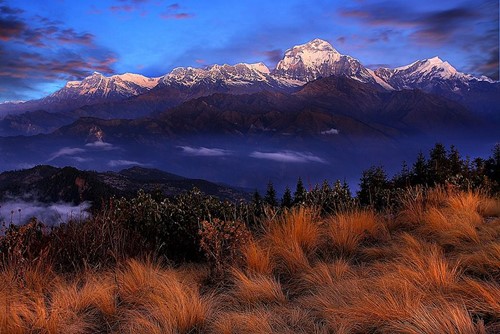
Hike in Nepal: The vista from the iconic Poon Hill, Annapurna panorama trek, very close to Kathmandu.
What is the Weather Like Day to Day in the Himalayas?
During the day temperatures will be comfortable for walking but obviously, it will get colder as you get higher and it is important to pack what you need for the day, for example, hat and gloves, an extra layer and also a waterproof jacket and trousers. An umbrella is also useful for rain showers! The trek has many lodges and tea shops along the way, so there is always time to pop in for a cup of tea and shelter from bad weather. Follow the kit lists that we have on all our trip pages and call us anytime with any queries.
Is it Difficult to Trek in Nepal?
The trekking itself is not too difficult - hilly, of course - and the paths are easy to follow with just a few fundamental rules, such as always allowing a yak right of way. The altitude is what makes a challenging trek but a slow pace and a good acclimatization place which we provide will give you the best chance of a safe and enjoyable holiday. Just remember it's not a race! Trekking in Nepal is about embracing the culture of the people and immersing yourself in the atmosphere of the mountains.
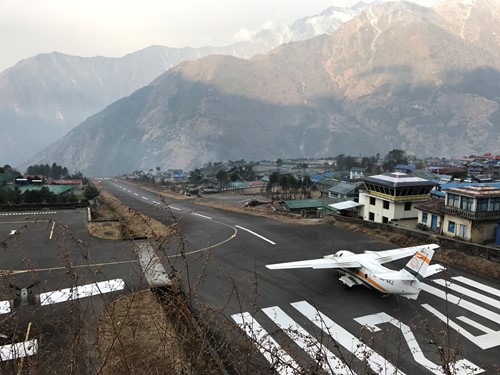
Nepal travel: The airstrip at Lukla, gateway to the Khumbu region and all the treks around the Everest massif.
What Do I Need to Pack to Trek in Nepal?
While trekking in Nepal you will be staying in teahouses, or lodges, most of the time. However, you will still need items like a four-season sleeping bag to stay warm and toasty. Regardless if you are on or off the trail, wearing proper layers is the key to staying comfortable while trekking in Nepal. Be sure to pack plenty of non-cotton base layers, midweight layers, like a fleece jacket or trekking pants, a puffy layer, and a wind layer. Gloves, hats, and a scarf or Buff is also a handy item.
While trekking you will carry a daypack, so be sure to pack plenty of water, snacks, sunscreen, extra layers and a camera in your daypack. Keep any valuables such as a passport on your person at all times. Trekking poles are essential to climbing the mighty trails in the Himalaya. You can either use a pair or a single pole. Trekking poles are widely available in Kathmandu, or you can bring your favourite pair from home.
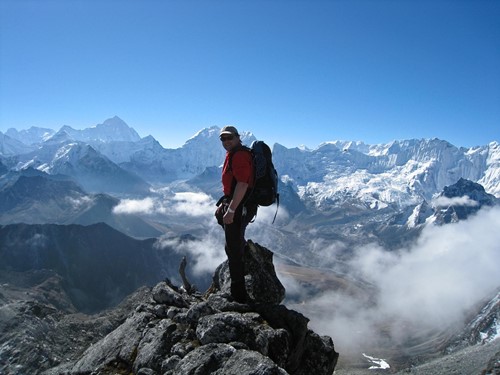
Enjoying the view of the mighty Himalayas!
How Can I Avoid Altitude Sickness?
Altitude sickness can strike at any time, however, there are a few things you can do to minimize your risk. Number one, stay hydrated. Be sure to drink plenty of water throughout the day. The higher you go, the more you will need to drink. Take your time ascending to higher altitudes. When you do arrive at your destination for the day, be sure to hike a little higher to a nearby hill and sleep lower. Be sure to eat at every meal. Altitude can cause you to not feel hungry, even though your body really needs to eat. Garlic soup and ginger tea are great for altitude. Also, take care of yourself mentally and physically. Be sure to clean yourself daily, either with wipes or a cup of hot water. Stay positive and relax. You are in one of the most beautiful places on the planet.
Trekking in the Himalayas of Nepal is an incredible experience. Surround yourself with jagged, steep mountains and experience the wonderful hospitality of the Nepalese people. No matter which trek you choose, you really can’t go wrong in this amazing country.
DO I NEED A VISA TO VISIT NEPAL?
Required permits; A visa is required for entry into Nepal and it can either be purchased on arrival or you can get it from your local Nepalese Embassy. For UK Nationals who wish to obtain a visa before arrival apply by post or in person with the Nepalese Embassy in London. For other nationalities you should check with your local Nepalese consulate. The easiest and cheapest way is to just get the visa on arrival in Nepal (check the Embassy website in advance for a list of nationalities that cannot get the Visa on arrival).

Nepal tours, The Kathmandu Valley is the most developed and populated place in Nepal. The majority of offices and headquarters are located in the valley, making it the economic hub of Nepal. It is popular with tourists for its unique architecture, and rich culture.
